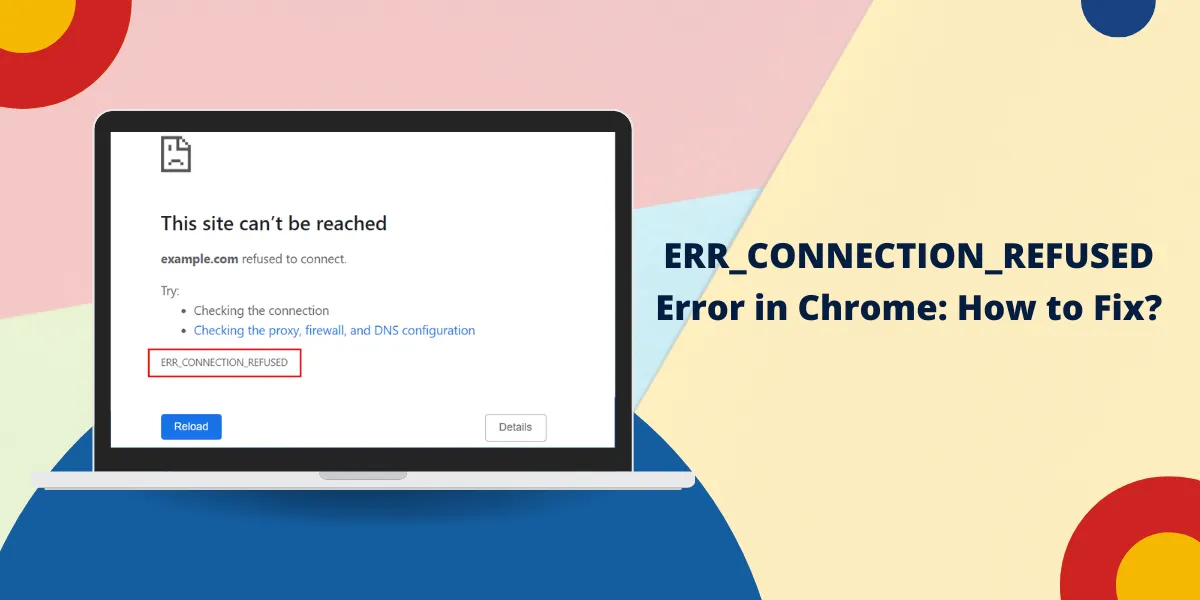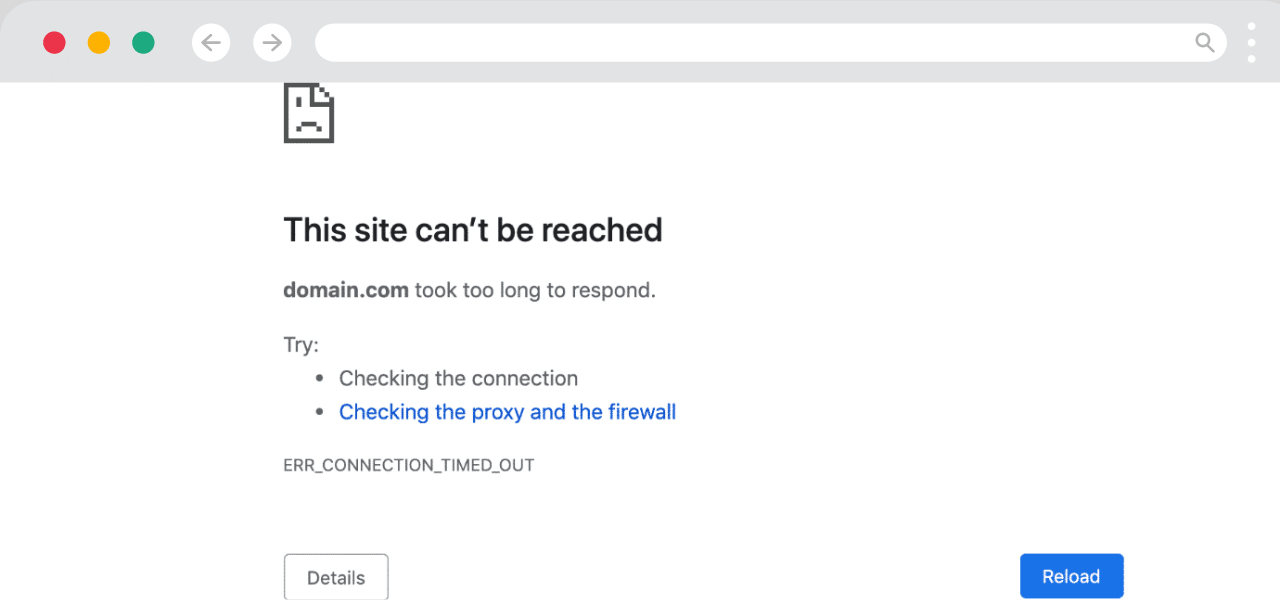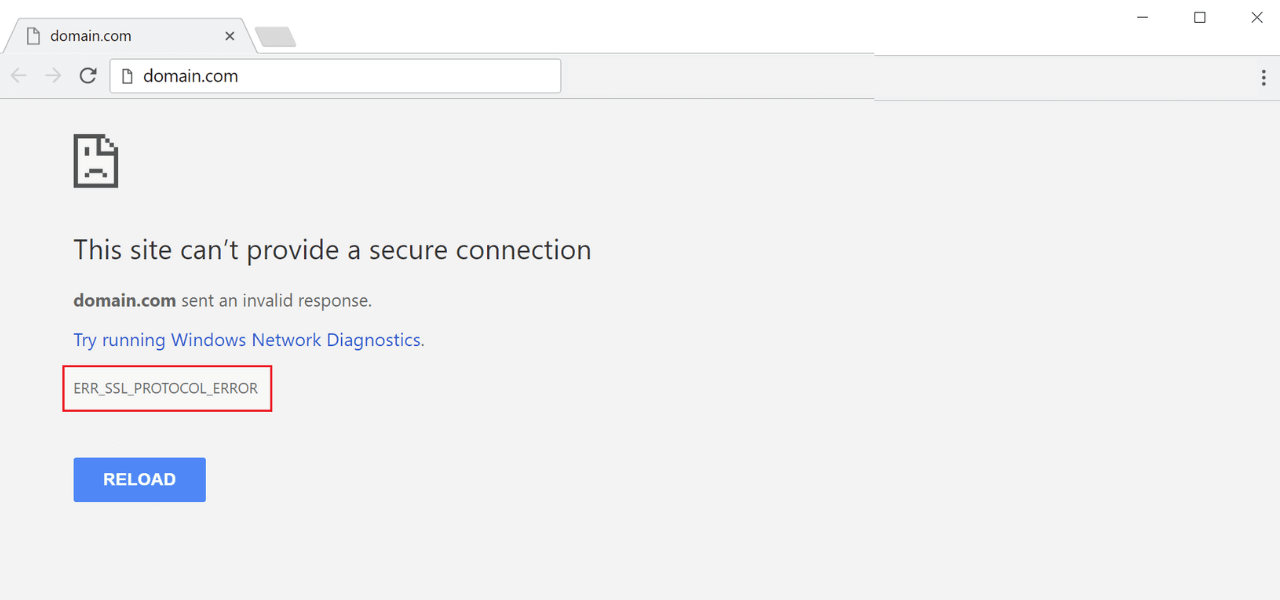What is the ERR_CONNECTION_REFUSED Error?
The ERR_CONNECTION_REFUSED error occurs when a web browser cannot establish a connection with a website’s server. This error appears when the server rejects the connection request or is unavailable.
Common causes include server downtime, incorrect port settings, firewall blocks, or DNS configuration issues. Users see this error as a notification in Chrome, Firefox, or other browsers when trying to access a webpage.
The error prevents webpage loading and requires troubleshooting steps like clearing browser cache, checking internet connection, or verifying server status to resolve the issue. Basic fixes include refreshing the page or restarting the browser.
10 Easy Solutions to Fix ERR_CONNECTION_REFUSED Error in Chrome
- Check the Website Status
- Restart Your Router and Modem
- Troubleshoot Your Internet Connection
- Disable Chrome Extensions
- Clear Chrome Browsing Data
- Reset Chrome Settings to Default
- Check Your Network Proxy Settings
- Make Sure Firewall is Not Blocking Chrome
- Add Site to Trusted Sites in Chrome
- Update Windows and Reboot
Solutions #1 Check the Website Status
The first step is always to check whether the website you are trying to visit is down or unavailable. Connection refused errors commonly occur when the server hosting the website has crashed or is offline for maintenance.
Try visiting the website from another device on another network. If it fails to load anywhere, the problem is likely server-side. Check the website’s social media channels or @username on Twitter for updates from the owners on any downtime.
You can also use “Is It Down Right Now?” sites like IsItDownRightNow to check the website’s current status. If the site indicates an outage or problems for that domain, you’ll have to wait for the issue to be resolved on their end.
Solutions #2 Restart Your Router and Modem
One quick fix for connection refused errors is to restart your network equipment. Issues like temporary glitches can often be resolved by rebooting your modem and router:
- Unplug the power cables for both devices. Wait 30 seconds.
- First, plug the modem back in and give it 2-3 minutes to come online fully.
- Next, plug in and reconnect your router. Allow 5 minutes for it to boot up and reconnect to the modem.
Once your home network is back up, try loading the website in Chrome again. This basic reboot sequence often clears up temporary hiccups, causing ERR_CONNECTION_REFUSED messages.
Solutions #3 Troubleshoot Your Internet Connection
If rebooting doesn’t help, investigate your overall internet connectivity next. The problem may be on your local network rather than the website.
Try these steps to troubleshoot your internet connection:
- Reset your network adapter: In Windows Settings > Network & Internet > Status, click Network Reset. This will reset your network adapter and internet protocol settings, which could resolve connectivity problems.
- Check other devices: Verify that the issue only occurs in Chrome by trying to access the site from a smartphone, tablet, or another computer on the same network. If they connect fine, the problem is isolated to your device.
- Test with an ethernet cable: If you’re on Wi-Fi, connect your computer directly to the router via ethernet cable and see if ERR_CONNECTION_REFUSED persists. If it loads normally, Wi-Fi signal issues may be causing the problem.
- Contact your ISP: If you have persistent connection problems, contact your internet service provider and ask them to diagnose the issue. There could be outages or faults in your area.
Solutions #4 Disable Chrome Extensions
Corrupted or problematic Chrome extensions are a common source of ERR_CONNECTION_REFUSED errors if they end up blocking connections to certain sites.
To troubleshoot, temporarily disable all extensions:
- Click the 3-dot menu > More Tools > Extensions
- Toggle off every extension on the page
- Reload the problematic website and see if the error persists
If the site now loads fine, turn extensions back on one by one until you identify the problematic add-on. You can then remove the faulty extension or find an alternative. This often resolves ERR_CONNECTION_REFUSED messages.
Solutions #5 Clear Chrome Browsing Data
Over time, browsing data like cookies, cached files, and browsing history can become bloated or corrupted. This can prevent Chrome from establishing proper connections.
Try clearing your browsing data as a fix:
- Click the 3-dot menu > Settings > Privacy and security
- Click Clear browsing data
- Select Cookies, Cached images/files, and check all other options
- Choose the maximum timeframe All time
- Click Clear data
- Restart Chrome and reattempt loading the website
With your browsing data wiped Chrome will rebuild the necessary files, allowing you to connect. This commonly resolves ERR_CONNECTION_REFUSED errors.
Solutions #6 Reset Chrome Settings to Default
If corrupted settings are causing connection issues, resetting Chrome to factory defaults may help:
- Type chrome://settings/resetProfileSettings into the address bar
- Click Reset settings
- Restart Chrome and test the website again
Resetting erases customized settings and restores defaults, such as the search engine, new tab page, extensions disabled, and startup options. The fresh settings often resolve website connection problems.
Solutions #7 Check Your Network Proxy Settings
Chrome’s default proxy settings typically work fine for most networks. But if you use a manual proxy setup, incorrect configurations can prevent Chrome from connecting and produce ERR_CONNECTION_REFUSED.
To check your proxy settings:
- Go to Settings > Network & Internet > Proxy
- If set to Manual, click on the connection name and make sure the Address and Port details match your network
- If you don’t use a proxy, Select Direct connection = No proxy
- Alternatively, have Chrome auto-detect your proxy settings
With the proper proxy setup applied, websites should load correctly.
Solutions #8 Make Sure Firewall is Not Blocking Chrome
Firewalls help protect your network by limiting connections. But sometimes, they can be overzealous and block Chrome from accessing legitimate websites, causing ERR_CONNECTION_REFUSED errors.
Check if your firewall settings are interfering:
- Open your firewall configuration (Windows Firewall or your security software)
- Look for any blocked applications, connections, or website domains related to Chrome
- Remove any limitations imposed on Chrome connections to resolve the error
Solutions #9 Add Site to Trusted Sites in Chrome
For a specific site giving you persistent ERR_CONNECTION_REFUSED issues, you can add it as a trusted site in Chrome:
- Go to Settings > Privacy and security
- Scroll down to the Security section
- Click Site settings
- Click Add under Trusted sites
- Enter the problematic domain, then click Add
This will exempt the site from Chrome’s security restrictions that may be blocking connectivity.
Solutions #10 Update Windows and Reboot
As a last resort, perform a full Windows update and restart your device:
- Open Windows Update settings
- Click Check for updates
- Install any available updates and let the system reboot
Updating Windows and drivers can resolve unforeseen OS-level issues causing connectivity problems in Chrome. After rebooting, websites should load normally without ERR_CONNECTION_REFUSED.
Final Thoughts
In summary, the ERR_CONNECTION_REFUSED message in Chrome typically indicates a failure to establish communication with the website’s server. While frustrating, the error can often be resolved through troubleshooting steps like resetting network equipment, verifying website status, clearing browser data, adjusting settings, disabling extensions, and updating software.
If Chrome is the only browser affected, focus solutions there. But if the error persists across devices and browsers, it likely means the website itself is currently unreachable. Patience may be required until any downtime or maintenance is finished. Tracking a site’s status via Twitter or outage services can provide updates on when connectivity will be restored.
Frequently Asked Questions About ERR_CONNECTION_REFUSED
Why does ERR_CONNECTION_REFUSED happen in Chrome?
This error occurs when Chrome is unable to establish a connection to the website’s server to load the page. Common causes include website outages, network problems, issues with Chrome settings/data, other software interfering, high server traffic, or domain configuration issues.
How is it a problem on my end or the website’s end?
Try accessing the website from different devices, networks, and web browsers. If the error persists everywhere, the website is likely down or unreachable. If it only occurs in Chrome on your device, the problem is on your end.
What are some common ways to fix ERR_CONNECTION_REFUSED?
Restart your device, router, and modem. Check for network connection issues. Clear your Chrome cache/data. Disable extensions and plugins. Reset Chrome settings. Make sure proxies, firewalls, and VPNs aren’t blocking connections: update network drivers and Windows.
The site works in Edge but not Chrome; why?
This indicates the issue is isolated to Chrome. Likely culprits include corrupted data/settings, problematic extensions, Chrome configuration issues, conflicts with other software installed on your machine, etc. Troubleshooting steps specific to Chrome often resolve it.
How do I fix ERR_CONNECTION_REFUSED on my Android phone?
Turn airplane mode on and off, clear the Chrome app cache and data, check for Android OS and Chrome app updates, restart your phone, or try resetting network settings under Settings > System.
What is the ERR_TIMED_OUT error in Chrome?
ERR_TIMED_OUT indicates a specific connection timeout when communicating with the server. It may occur if the site is slow or overloaded. Try clearing browsing data or waiting before retrying.
Why does Chrome say DNS_PROBE_FINISHED_NO_INTERNET?
This suggests a DNS lookup failure. To potentially fix it, restart devices, flush DNS, renew IP, or use Google’s DNS servers 8.8.8.8 and 8.8.4.4.
How do I allow Chrome through the firewall?
Open your firewall settings, go to allowed apps, and make sure Chrome isn’t being blocked. You can also add it to the exceptions list.
Can antivirus software cause connection errors in Chrome?
Yes, security products can sometimes block Chrome access to certain sites. Try adding the domain in question to the antivirus exclusions list.
What’s the difference between ERR_CONNECTION_REFUSED and ERR_CONNECTION_RESET?
ERR_CONNECTION_REFUSED means the server actively rejected the connection. ERR_CONNECTION_RESET indicates the connection was forcibly closed by the server after initially being established.

Priya Mervana
 Verified Web Security Experts
Verified Web Security Experts
Priya Mervana is working at SSLInsights.com as a web security expert with over 10 years of experience writing about encryption, SSL certificates, and online privacy. She aims to make complex security topics easily understandable for everyday internet users.



